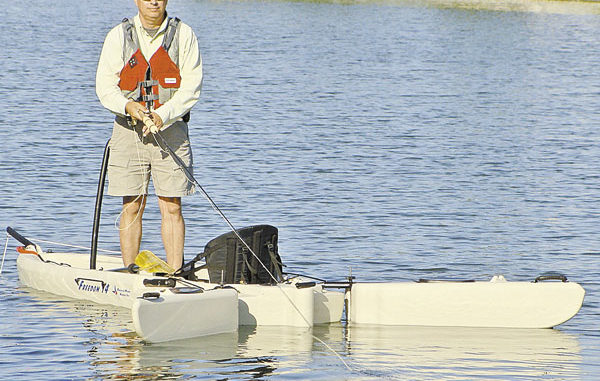
What do Bigfoot, the alien autopsy at Roswell, Manbearpig and stand-up kayak fishing all have in common?
They were once all considered urban legends. By definition, an urban legend is a form of modern folklore that is alleged to be true, but is often false or exaggerated.
Of course, we now know that stand-up kayak fishing is real. Incidently, so is Manbearpig (half-man, half-bear, half-pig).
Claims that one could stand up and fly cast from a typical sit-inside kayak (SINK) weren’t exactly false. You could do it if you were short and thin, and had the balance of an Olympic gymnast. Other than that, you were bound to take a swim soon and often.
Although sit-on-top (SOT) kayaks had been around since the 1970s, it wasn’t until anglers embraced them that their popularity exploded. Not as fast as the SINKs, they offered superior stability and storage capacity — the two features that fishermen demand.
Even so, only a few SOTs can rightfully claim stand-up stability (although many claim to). The reason is simple: Most boats are still built for speed. As Cormier’s First Law of Puddling states, “Selecting a kayak for fishing is an exercise in compromise.” You can’t have a narrow kayak that delivers speed and at the same time have the broad width necessary for counter-balancing a standing, shifting weight.
At least that was the compromise.
The first standup-capable boats, like the Cobra Fish-and-Dive and Ocean Kayak Drifter, were built on wide hulls — 32 inches or more. Even today, these remain popular and have been joined by even wider boats such as the Big Game Prowler and the Hobie Pro Angler.
Designers know there are a few tricks to adding balance without adding a lot of width (and loss of speed). One method is to utilize pontoon-shaped hulls. The Native Ultimate and Wilderness Systems Ride employ this design.
Another method is to add stabilizers. Now stabilizers can be added to any kayak, and they offer stability without much sacrifice in speed — provided they are of the hydrodynamic variety. But stabilizers also take up a lot of wingspan that can be a royal pain when paddling through broken marsh. And depending on where they’re mounted, they can interfere with paddling itself.
See? There’s always a compromise.
So when my good friend Tom Jindra, regional sales rep for the Grand Slam Group, called last October and told me he was now marketing a kayak with built-in stabilizers that defied my first law, my response was “show me.”
Jindra arranged a tryout on Bayou St. John in New Orleans. I must admit, the Freedom Hawk 14 was a rather strange-looking yak — the entire front deck was flat, and just behind the seat, the stern was split into two halves. Pulling a lever on each side of the seat extended the halves (stabilizers) out like a V-shape.
I put the FH14 through my usual battery of tests for speed, tracking, maneuvering and stability. With the stabilizers tucked in, the speed was pretty decent, and it tracked reasonably well.
It’s real strength shined on the last test. I opened up the wings, and used the brace to lift myself up. Immediately I realized this was as stable as any yak I’d ever been in.
Since that time, Freedom Kayaks has introduced a 12-foot version of this boat. In addition to being shorter and lighter, it also offers an upgrade in the stabilizer deployment. The wings now swing out so as to be parallel to the main hull. This allows paddling even in use.
So is the Freedom Hawk a gimmick or the real deal?
Anyone looking for speed will still be better off with the likes of the Tarpon 140, Ocean Kayak Trident or Hobie Revolution. And anyone looking for comfort and capacity will opt for the Native Ultimate or Wilderness Commander. And at 79 pounds for the FH14 (64 pounds for the FH12), it’s not the lightweight solution that the OK Caper and the Cobra Navigator are.
But for what it allows, it’s faster and lighter and less expensive than most of its competition.
It allows you to stand up in any position, even pole through shallow marsh, sightcasting to reds, drum and sheepshead swimming around you. That’s a compromise I’d be willing to make.
Freedom Kayaks are carried by Backpacker in Baton Rouge and Lafayette, and Pack and Paddle in Lafayette. Attend one of their demo days, or ask for a personal demo.


